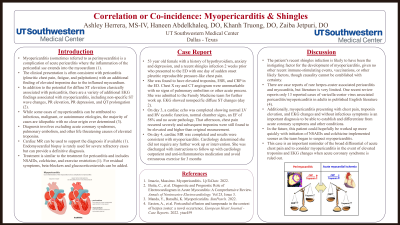Back

Clinical: General Topics
Correlation or Coincidence: Myopericarditis & Shingles
Friday, March 31, 2023
12:00 PM East Coast USA Time


Ashley Herrera, MS
UT Southwestern Medical Center
Dallas, Texas, United States
Presenting Author(s)
Introduction: Myopericarditis is a complication of acute pericarditis where the inflammation of the pericardial sac extends into the myocardium. The clinical presentation is often consistent with pericarditis (pleuritic chest pain, fatigue, and palpitations) with an additional finding of elevated troponins due to the inflamed myocardium. In addition to the potential for diffuse ST elevation classically associated with pericarditis, there are a variety of additional EKG findings associated with myopericarditis. While some cases of myopericarditis can be attributed to infectious, malignant, or autoimmune etiologies, the majority of cases are idiopathic with no clear origin ever determined. Diagnosis involves excluding acute coronary syndromes, pulmonary embolism, and other life threatening causes of elevated troponins. Cardiac MR can be used to support the diagnosis. Endomyocardial biopsy is rarely used for severe refractory cases but can provide a definitive diagnosis. Treatment is similar to the treatment for pericarditis and includes NSAIDs, colchicine, and exercise restriction.
Case Study: 53 year old female with a history of recent shingles flare who presented with a sudden onset pleuritic reproducible pressure-like chest pain. She was found to have elevated troponins, ESR, and CRP. Imagings were unremarkable. She was admitted for further work up. EKG showed nonspecific diffuse ST changes (day 2). On day 3, a cardiac echo was completed showing normal LV and RV systolic function and an EF of 58%. That afternoon, chest pain recurred severely and subsequent troponins were still found to be elevated. On day 4, cardiac MR was consistent with myopericarditis. Cardiology determined no further work up or intervention. She was discharged with instructions to follow up with cardiology outpatient and avoid extraneous exercise for 3 months.
Discussion: Patient’s recent shingles infection is likely to have been the instigating factor for the development of myopericarditis, given no other recent immune-stimulating events, vaccinations, or other likely factors, though causality cannot be established with certainty. There are case reports of rare herpes-zoster associated pericarditis and myocarditis, but literature is very limited; one recent literature review reports only 13 reported cases of varicella-zoster virus associated myopericarditis in adults in published literature. In the future, this patient could hopefully be worked up more quickly with initiation of NSAIDs and colchicine implemented sooner as the team began to suspect myopericarditis. This case is an important reminder of the broad differential of acute chest pain and to consider myopericarditis in the event of elevated troponins and EKG changes when acute coronary syndrome is ruled out.
Case Study: 53 year old female with a history of recent shingles flare who presented with a sudden onset pleuritic reproducible pressure-like chest pain. She was found to have elevated troponins, ESR, and CRP. Imagings were unremarkable. She was admitted for further work up. EKG showed nonspecific diffuse ST changes (day 2). On day 3, a cardiac echo was completed showing normal LV and RV systolic function and an EF of 58%. That afternoon, chest pain recurred severely and subsequent troponins were still found to be elevated. On day 4, cardiac MR was consistent with myopericarditis. Cardiology determined no further work up or intervention. She was discharged with instructions to follow up with cardiology outpatient and avoid extraneous exercise for 3 months.
Discussion: Patient’s recent shingles infection is likely to have been the instigating factor for the development of myopericarditis, given no other recent immune-stimulating events, vaccinations, or other likely factors, though causality cannot be established with certainty. There are case reports of rare herpes-zoster associated pericarditis and myocarditis, but literature is very limited; one recent literature review reports only 13 reported cases of varicella-zoster virus associated myopericarditis in adults in published literature. In the future, this patient could hopefully be worked up more quickly with initiation of NSAIDs and colchicine implemented sooner as the team began to suspect myopericarditis. This case is an important reminder of the broad differential of acute chest pain and to consider myopericarditis in the event of elevated troponins and EKG changes when acute coronary syndrome is ruled out.
